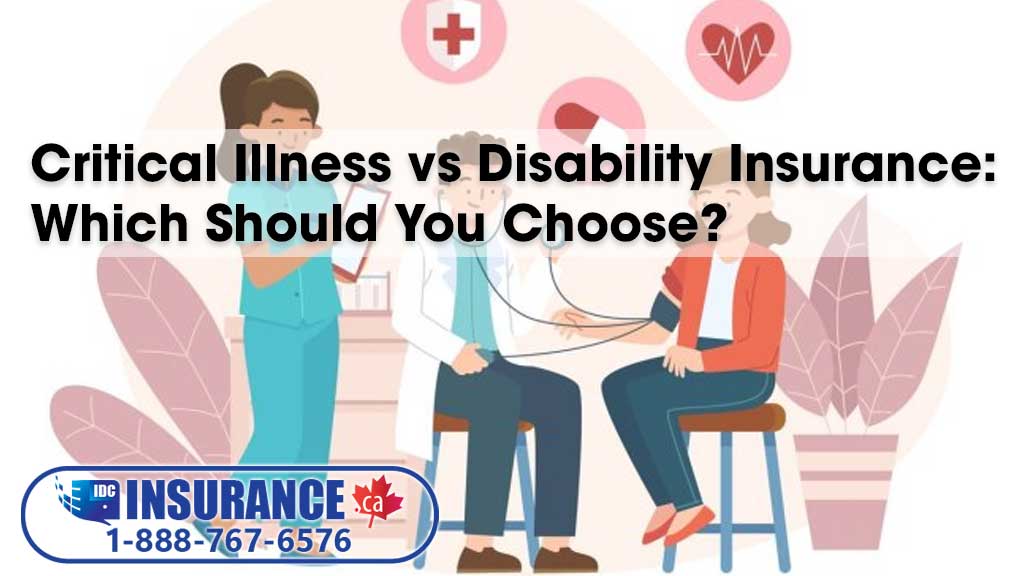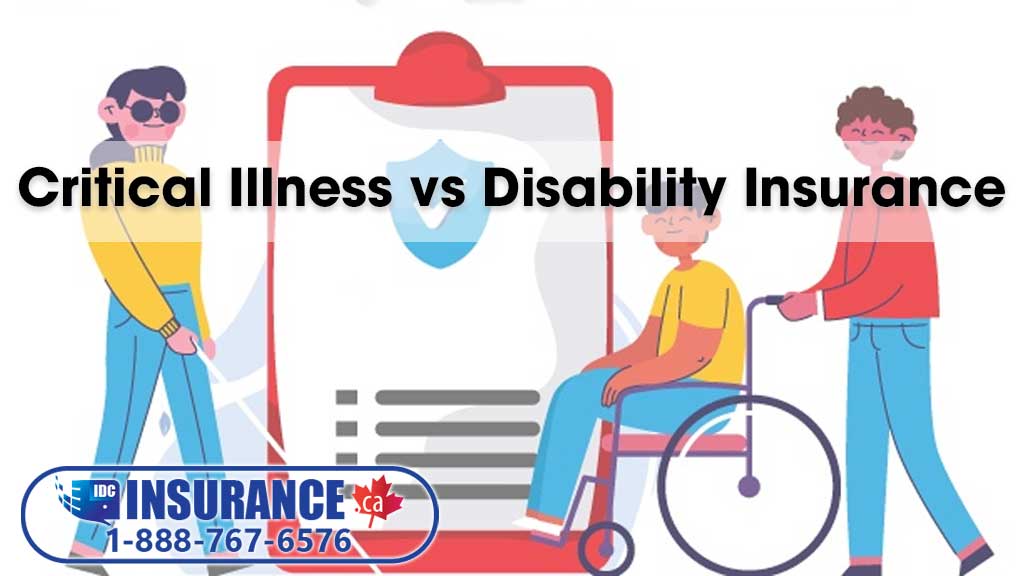Introduction
Critical illness vs disability insurance are two important types of coverage for Canadians to consider. They provide financial protection and peace of mind in the event of a serious health crisis or unexpected injury that prevents someone from working.
With critical illness and disability being far more common than many realize, having adequate coverage is essential to maintain your standard of living and avoid financial devastation. This article will provide an in-depth look at critical illness vs disability insurance, key differences, when you may need both, and how to determine the right coverage for your unique situation.
What is Critical Illness Insurance?
Critical illness insurance provides a lump sum cash payment if diagnosed with one of a list of specified critical illnesses. Policies typically cover between 25-30 of the most common critical conditions, including:
- Cancer
- Heart attack
- Stroke
- Multiple sclerosis
- Parkinson’s disease
- Major organ transplant
- Kidney failure
- Aplastic anemia
- Blindness
- Paralysis
The lump sum payment can be used for any purpose – medical treatments, daily living expenses, paying off debts, travel for care, home modifications, etc.
A key feature of critical illness insurance is that the payment is made regardless of your ability to work or earn an income after diagnosis. Even if you make a full recovery and return to your job, you still receive the full payout.
Critical illness insurance is available in coverage amounts ranging from $25,000 up to $2 million or more. You choose the dollar amount at the time of purchase. Payouts are tax-free and usually made in one lump sum, providing important funds when you need them most.
What is Disability Insurance?
Disability insurance provides income replacement if injury or illness prevents you from working. It is designed to replace a portion of your earnings through tax-free monthly payments while recovering from a disability.
There are two main types of disability insurance:
Short-term disability – Replaces income for disabilities lasting between 4 weeks and six months.
Long-term disability – For disabilities lasting longer than short-term, even permanently. Can pay benefits until age 65.
Disability insurance covers a wide range of conditions that may prevent someone from working, including:
- Back or neck injuries
- Broken bones
- Cancer
- Cardiovascular disease
- Chronic pain disorders like arthritis
- Depression and anxiety
- Diabetes
- MS
- Severe concussion
- And more
Monthly payments are meant to cover living expenses like mortgage/rent, groceries, utilities, etc. Payments stop once you recover and return to work or reach the end of your coverage period.
Related: Mortgage Protection Insurance
Key Differences Between Critical Illness vs Disability Insurance
While critical illness insurance and disability insurance both offer important financial protection related to your health, there are some key differences:
How the Benefit is Paid
- Critical Illness – Provides a one-time, lump sum cash payment
- Disability – Provides monthly income payments
When the Benefit is Paid
- Critical Illness – Pays upon diagnosis of a covered critical illness
- Disability – Pays when unable to work due to illness/injury
Conditions Covered
- Critical Illness – Covers major illnesses like cancer, stroke, heart attack, MS, Parkinson’s, etc.
- Disability – Covers any condition preventing the ability to work
Duration of Coverage
- Critical Illness – Can be purchased for lifetime coverage
- Disability – Coverage ends at age 65
Availability of Coverage
- Critical Illness – Can be purchased by anyone, employed or not
- Disability – Requires employment to qualify
When You May Need Both Critical Illness and Disability Insurance
There are many situations in which having both critical illness and disability insurance can provide important layered protection:
Critical Illness Causing Disability
If you are diagnosed with a critical illness that makes you unable to work, you can receive the payout from critical illness insurance plus monthly disability benefits.
It’s important to understand that a critical illness diagnosis alone does not trigger disability insurance benefits. The critical illness must also cause an inability to work in order to receive disability payments.
For example, a heart attack that results in medical complications or limitations and requires extended recovery time that prevents someone from performing their occupational duties would trigger payouts from both policies – a lump sum from critical illness insurance and monthly income from disability insurance.
However, if someone has a heart attack but is able to return to work within the disability waiting period, they would not qualify for disability benefits.
Separate Conditions
It’s possible to suffer separate medical conditions covered under each policy.
Someone diagnosed with cancer could receive their critical illness payout and later suffer an injury covered under disability insurance if it prevented them from working.
Comprehensive Protection
Even without overlapping conditions, having both policies provides more comprehensive protection – critical illness insurance for major diseases, and disability insurance for illnesses/injuries affecting your income.
How Critical Illness Insurance Can Save You Money
Being diagnosed with a critical illness like cancer or heart disease can be extremely expensive, even with provincial healthcare. Critical illness insurance provides funds to help cover costly treatments, so you don’t have to drain your savings.
For example, take an individual diagnosed with leukemia (a form of blood cancer) at age 40. Here are sample costs they may incur:
- Prescription drugs: $5,000/month x 12 months = $60,000
- Stem cell transplant: $100,000
- Travel for specialized treatments: $15,000
- Childcare help: $4,000/month x 6 months = $24,000
- Total: $199,000
Now imagine facing these expenses without critical illness insurance. Even with insurance from work, costs could easily exceed $100,000.
A critical illness policy providing a $150,000 lump sum payout could cover 75% of costs in this scenario. This demonstrates the value of critical illness insurance in alleviating financial stress during medical trauma.
How Disability Insurance Can Save You Money
Becoming disabled with no disability insurance can be financially catastrophic. Disability coverage provides crucial income replacement so you can focus on recovery without draining savings.
Let’s look at an example. A 45-year-old professional earning a gross income of $80,000/year becomes fully disabled due to a back injury. Monthly expenses are $5,000. Here is the financial impact with and without disability insurance:
Without Disability Insurance
- Income replaced: $0
- Savings used over 12 months: $60,000
- Government disability benefit: $1,500/month x 12 months = $18,000
- Total income loss: $60,000
With Disability Insurance
- Individual disability policy paying 60% of income: $4,000/month x 12 months = $48,000
- Savings used: $12,000
- Government disability benefit: $18,000
- Total income loss: $12,000
This example shows how disability insurance significantly reduces financial hardship in a disabling event. The individual with coverage preserves their savings and has $48,000 less in expenses over the year.
How Much Disability and Critical Illness Insurance Do You Need?
Determining adequate coverage amounts for disability insurance and critical illness insurance depends on several factors:
Income Replacement Needs
Consider your monthly expenses and what portion of income requires replacement if unable to work. This helps calculate required disability insurance coverage.
Medical Costs
Think about potential treatment costs not covered by provincial healthcare. The lump sum from critical illness insurance helps pay these expenses.
Existing Illnesses and Risk Factors
Pre-existing conditions and family history may warrant higher coverage amounts for added protection.
Other Income Sources
Account for sickness benefits from work and any coverage your spouse may have when deciding how much you need.
Age and Life Stage
Your financial obligations and resources likely differ at age 30 compared to 50. Ensure your coverage aligns with your current situation.
To determine the right amount of disability insurance and critical illness insurance for your specific circumstances, having a licensed advisor review your unique needs is invaluable.
Disability Insurance Options in Canada
There are several options for obtaining disability insurance coverage in Canada:
Employer-Provided Plans
Many companies offer group disability benefits to employees. Understand what your work coverage includes and if it meets your income replacement needs.
Private Disability Insurance
You can purchase an individual disability insurance policy from an insurance company. This allows customization of your coverage.
Professional Association Plans
Certain professional organizations and associations provide disability coverage for members.
Government Programs
Federal and provincial government disability benefits provide basic coverage but usually only pay a small percentage of income.
Having a professional evaluate your disability insurance options ensures you get adequate coverage tailored to your unique situation.
Critical Illness Insurance Policy Options in Canada
Critical illness insurance coverage can be purchased through:
Individual Policies
Purchasing your own standalone critical illness insurance policy allows complete flexibility to customize coverage to meet your needs.
Employer Plans
Some employee benefits packages provide basic critical illness insurance. Check if yours does and if the coverage is sufficient.
Riders on Life Insurance
Certain life insurance policies allow adding critical illness coverage as a rider for added protection.
Spousal Coverage
Spouses can purchase policies for each other to protect themselves from critical illness.
For the best critical illness insurance for your circumstances, working with an advisor helps you navigate the options and ensure adequate coverage.
Should You Buy Critical Illness or Disability Insurance First?
Determining which type of coverage to purchase first often depends on your employment status:
Employees
Many employees already have some disability insurance through work benefits. For added protection, buying supplemental critical illness coverage often makes sense first.
Self-Employed
Without employer disability benefits, purchasing your own disability policy first is likely the priority to replace potential lost income.
Spousal Coverage
Couples should think about insuring the main breadwinner with disability coverage first, and then adding critical illness insurance for the other partner.
In any situation, a licensed advisor can provide guidance on optimizing your critical illness and disability insurance strategy.
Applying for Critical Illness and Disability Insurance
Applying for individual critical illness insurance and disability insurance policies involves a similar process:
Application Form
Fill out an application requiring personal details, medical history, lifestyle information, and beneficiary designation.
Underwriting
Insurers will underwrite and assess your application to determine eligibility and pricing. Factors considered include age, health, family history, occupation, and hobbies.
Doctor’s Exam
A medical exam, blood profile, or medical records may be required depending on age and amount of coverage sought.
Policy Issue
If approved, the insurance company will issue the policy after your application is processed and underwriting completed.
Working with an experienced insurance advisor simplifies the application process and ensures you receive the optimum approvals.
Critical Illness and Disability Insurance Claims Process
If faced with a critical illness diagnosis or disabling injury, follow these steps when filing your insurance claims:
Notify Provider
Contact your insurance provider immediately to begin a claim. Provide information on diagnosis, doctors, onset of symptoms, and any evidence you may have.
Confirm Requirements
The insurance company will explain what supporting medical and financial documents you need to submit based on your specific claim.
Submit Claim Forms
Fill out all required claim forms thoroughly and accurately based on condition details and physician input. Sign any release authorizations.
Provide Supporting Docs
Supply all supplementary paperwork requested – medical certificates confirming the diagnosis, hospital records, employment details, financial information, etc.
Claim Decision
The insurance company will inform you of their claim decision after assessing all documentation provided.
Follow Up
If your claim is denied, ask for a detailed explanation in writing. Dispute any unjustified denials.
Taking these steps allows you to present the strongest claim possible and receive the benefits you are entitled to.
Critical Illness vs Disability Insurance: Which Should You Choose?

Deciding whether critical illness or disability insurance is the right choice depends on your employment status, budget, health risks, and insurance priorities. Here are some key considerations:
Pros of Critical Illness Insurance:
- A lump sum payout helps cover medical and everyday living costs
- Pays regardless of ability to work
- Covers major conditions like cancer, stroke, heart attack
- Available to anyone, regardless of employer
Cons of Critical Illness Insurance:
- Not designed for income replacement
- Limited conditions covered
- More expensive than disability insurance
Pros of Disability Insurance:
- Replaces lost income by providing monthly payments
- Covers any injury/illness causing inability to work
- Costs less than critical illness coverage
Cons of Disability Insurance:
- Doesn’t cover diagnosis, only income loss from disability
- Requires the ability to work to qualify
- Benefits end at age 65
Critical illness insurance and disability insurance both play important yet distinct roles in protecting against the financial impact of health crises. Critical illness insurance provides a lump sum payment upon diagnosis of a major condition to cover costs, while disability insurance replaces income lost from being unable to work.
The purpose of each is unique – critical illness for medical expenses and disability for income replacement. While budget and existing benefits may lead some to prioritize one over the other, many Canadians benefit from having both types of coverage for comprehensive protection.
Ultimately, your insurance advisor can help determine if critical illness, disability insurance, or both policies are best suited to your unique situation. Discuss your specific needs and leverage expert guidance to ensure you have adequate and affordable coverage tailored to your circumstances.
Conclusion
Critical illness insurance and disability insurance provide complementary layers of protection when dealing with the financial fallout of serious health conditions.
Understanding key differences allows you to select the right combination of coverage tailored to your employment status, existing benefits, income needs, and health risks.
Working with a licensed advisor simplifies finding the optimal critical illness and disability insurance to protect your finances, lifestyle and peace of mind.
Next Steps
We hope this overview has provided greater insight into critical illness insurance and disability insurance in Canada. As a next step, we recommend connecting with one of our licensed advisors to discuss your specific situation.
Our advisors have helped thousands of Canadians find the right insurance solutions. We make it easy to compare quotes from top insurance providers and guide you in determining adequate coverage for your unique needs.
To get started, simply visit our website IDC Insurance Direct Canada and request a callback. Our experts are ready to help assess your critical illness and disability insurance options and ensure you have financial protection in case of a storm.
Don’t delay – give us a call today and invest in your peace of mind.
FAQs related to critical illness insurance vs. disability insurance in Canada:
[rank_math_rich_snippet id=”s-119959f5-5704-486d-835a-4e05dd9493c3″]










